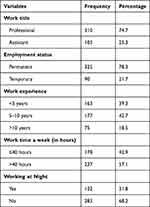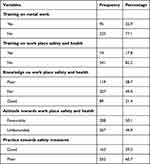Back to Journals » Risk Management and Healthcare Policy » Volume 17
Compliance with Standard Occupational Health and Safety Measures and Associated Factors Among Small-Scale Metal Industry Workers in Central Ethiopia
Authors Afework A , Tamene A , Tafa A
Received 17 January 2024
Accepted for publication 24 February 2024
Published 29 February 2024 Volume 2024:17 Pages 399—409
DOI https://doi.org/10.2147/RMHP.S455967
Checked for plagiarism Yes
Review by Single anonymous peer review
Peer reviewer comments 4
Editor who approved publication: Dr Gulsum Kubra Kaya
Abel Afework,1,2 Aiggan Tamene,3– 5 Abera Tafa2
1Center for Sustainable Development, Addis Abeba University, Addis Abeba, Ethiopia; 2Infection Prevention and Control department, Dilla University, Dilla, Ethiopia; 3Centre for Sustainability, University of Otago, Dunedin, New Zealand; 4Department of Preventive and Social Medicine, University of Otago, Dunedin, New Zealand; 5Department of Environmental Health Sciences, Wachemo University, Wachemo, Ethiopia
Correspondence: Abel Afework, Email [email protected]
Background: Compliance with workplace health and safety measures can result in considerable reduction in workplace injuries and fatalities and attributed economic costs. However, majority of studies conducted in small-scale industries in numerous countries, including Ethiopia focused on the prevalence of occupational injuries and there is a paucity of evidence on level of employees’ adherence to safety measures and the associated factors. Therefore, this study was conducted to assess workers’ compliance and factors associated with occupational health and safety practices in small-scale metal industries in Central Ethiopia.
Methods: This study was conducted in Central Ethiopia. A total of 415 small-scale metal workers were included in this study. Study participants were selected using a simple random sampling technique. A structured interviewer-administered questionnaire was used to collect the data. The collected data were entered using EPI Info version 7.2 and exported to IBM-SPSS Version 22 for further cleaning and analysis. Bivariate and multivariate Binary Logistic Regression were conducted to determine association and during the multivariable regression variables with a p-value < 0.05 were considered significantly associated factors.
Results: The study found a 39.3% (95% CI: 34.7, 44.1) prevalence of good compliance with safety and health measures among small-scale metal workers. Temporary employed workers were less likely to adhere [AOR=0.43, 95% CI (0.21, 0.93)] and workers who received training were more likely to adhere [AOR=5.75, 95% CI (2.56, 12.9)] to safety precautions. Other significantly associated variables included work experience, working at night, and satisfaction with the current salary.
Conclusion: This study sheds light on small-scale metal workers’ commitment to workplace safety and health procedures, indicating a compliance rate of 39.3%, which is low. Temporary employees and less experienced workers are less likely to follow health and safety precautions. Workplace health and safety training are associated with increased safety precautions.
Keywords: safety compliance, health and safety, small-scale industries, metal workers, Ethiopia
Background
Occupational health and safety refers to the measures, policies, and practices that organizations and employees should adhere to guarantee the health and safety of employees and improve their overall productivity and performance.1,2 The implementation of simple preventive health and safety measures like using safety manuals and wearing protective gears during working hours can result in a considerable reduction in the loss of human life and economic costs associated with workplace injuries and fatalities.3
The International Labor Organization has reported that the annual estimated work-related fatalities and non-fatal injuries are 2.78 million and 374 million, respectively. Furthermore, the estimated global economic loss linked to workplace injuries is approximately 3.9% of global Gross Domestic Product (GDP), with 1473 billion euros and 1207 billion euros lost owing to fatal and non-fatal incidents, respectively,4,5
Industrialized nations have long acknowledged the importance of occupational health and safety. Employee compliance with health and safety regulations is a priority for the industries and stakeholders in these countries. However, occupational health and safety are prioritized less in developing countries, and many businesses continue to lack the bare minimum of health and safety protocols, exposing their employees to a wide range of workplace hazards.6 Small-scale industries are industries that have 10 to 20 workers and mainly utilize hand tools for production. The nature of the work in combination with the poor health and safety management systems and failure to comply with health and safety procedures exposes the employees to hazards.7,8
Small-scale metal industries are among the most dangerous jobs in developing countries, with a wide range of occupational hazards responsible for many fatal and nonfatal workplace injuries.9,10 However, most employees in these businesses did not follow health and safety procedures and Occupational Health and Safety (OHS) adherence remained low. Lack of attention by managers, employee educational status, income, lack of training on health and safety, lack of knowledge on health and safety, negative/poor perception regarding health and safety measures, lack of procedures or regulations, lack of safety materials, and poor supervision/inspection are the main reasons for non-compliance with health and safety measures.11–13
Small-scale industries in Ethiopia are among the most dangerous places to work, with an annual prevalence of self-reported occupational injuries ranging from 30% in the Bale Zone to 58.2% in Mekelle City.14,15 Metal sectors have a greater rate of occupational injuries and majority of employees did not adhere to occupational safety and health standards such as proper use of personal protective equipment.16–18 The prevalence of PPE use was observed to be 76.2% among small-scale metal workers, with the linked characteristics of educational status, job experience, OHS training, and regulatory availability.19
Studies on the incidence of occupational hazards and injuries in small-scale companies conducted in numerous countries, including Ethiopia, have found a high prevalence of injuries and low compliance with OHS measures. But only limited studies had tried to find out those factors influencing adherence to OHS measures. Therefore, determining the level of OHS adherence and the factors influencing it is crucial. Therefore, this study aimed to assess workers’ compliance with occupational health and safety practices, as well as associated factors, in small-scale metal industries in Central Ethiopia.
Methods and Materials
Study Area
This study was conducted in Central Ethiopia. According to the city administration micro and small enterprise development office, there are more than 72 registered small-scale metal industries which have 5 and more workers within the town and peripheries, with a total of 631 metal workers.
Study Design and Period
An institutional-based cross-sectional study was conducted from May to July 2023.
Source and Study Population
Source population: The source population for this study was all small-scale metal industry workers.
Study population: The study population consisted of small-scale metal industry workers randomly selected from any work category.
Inclusion and Exclusion Criteria
Inclusion criteria: All small-scale metal industry workers who were involved in production activities during the study period were included in the study.
Exclusion criteria: workers aged <18 years and administrative workers those who are not directly involved in any of the production processes were excluded from the study.
Sample Size Determination and Sampling Technique
Sample Size Determination for First Objective
The sample size was calculated using the formula for a single population proportion in Epi Info Version 7.2 software.
The following assumptions were considered to calculate the sample size for the first objective:
- The hypothesized proportion of 50% to get the maximum sample size.
- 5% margin of error,
- 95% level of confidence (Z=1.96)
- 10% response rate
Accordingly, the sample size calculated for the study is 423.
Sampling Technique and Procedure
Prior to the list of small-scale metal industries, workers were obtained from the city administration’s micro and small enterprise development offices, and surveys were conducted for each small-scale metal industry. Then, workers were given a unique identifier, and Microsoft Excel randomizer was applied for the random selection of the total study participants.
Operational Definition
Practice towards safety measures: Respondents were asked 10 questions, each of which asked a five-point Likert scale agreement from “Always” to “Never”. Responses of “Always” and “Usually” were considered “Positive responses” and given a value of “1”, whereas responses’ of “Sometimes”, “Rarely” and “Never” were considered “Negative responses” and given a value of “0”. Practice was considered as “Good” considering a positive response for ≥80% by the respondent.
Knowledge regarding safety measures: Respondents were asked 10 knowledge-related questions, and the correct answer was given a value of 1, and for those incorrect answers, a value of 0 was given. Then, the total score was computed by summing up all the items together, and the respondents’ scores were categorized in to three categories: poor (≤50%), fair (51 to 75%), or good knowledge (>75%).
Attitude regarding safety measures: Respondents were asked 10 attitude-related questions using a five-point Likert scale. The respondent score was then computed by summing all the items together, and the respondents’ scores were dichotomized as favorable attitudes (> mean) or unfavorable attitudes (<mean).
Data Collection Instrument and Procedure
Data Collection Instrument
An interviewer-administered structured questionnaire was prepared by reviewing relevant literature. The questionnaire was prepared in English and translated into the Amharic language. It includes five main parts: participants’ socio-demographic characteristics, personal characteristics, information and knowledge characteristics, attitude, and practice-related characteristics (Additional File 1).
Data Collection Procedures
Before the data collection period, pre-testing of the questionnaire was conducted on small-scale metal workers in a town near the study area, using 5% (21 respondents) of total sample size, and necessary modifications were made before utilizing on the study participants. Face-to-face interviews were conducted privately, after written consent was obtained from each participant.
The study team consisted of one supervisor (MPH in Environmental Health) and three data collectors (BSc in Environmental Health) who had good experience in data collection and fluency in both Amharic and the local language. Training was provided for half a day (theoretical and field training) at the study site to the supervisor and data collectors prior to data collection.
Data Quality Control
To ensure the appropriateness and quality of the data collection, interviewers were discussed about half a day about the aim of the study, the contents of the instrument, and how to conduct it before starting data collection. Each day, the completed format was checked by the principal investigator to ensure the completeness and correctness of the data. Finally, the completeness of the questionnaire was checked before the analysis and interpretation.
Data Analysis
The collected data were coded and entered using the data entry template designed in Epi Info, version 7.2. The data were then cleaned by checking for outliers, inconsistencies, and missing values and analyzed using SPSS version 20 software.
Descriptive data are presented using frequencies, tables, and graphs. Bivariate analysis was conducted to examine various associations using a binary logistic analysis. All variables with a P-value <0.2 during the bivariate analysis were included for further fit to multivariable logistic regressions for better prediction of association. Crude and adjusted odds ratios with 95% confidence intervals was computed to determine the strength of association between the outcome and predictor variables. Statistical significance was set at p < 0.05.
Ethical Considerations
The study was conducted in accordance with the Declaration of Helsinki, and an ethical clearance approval letter was obtained from the Wachamo University Institutional Review Board. Written Informed Consent was obtained from each study participant before data collection which is approved by Wachamo University Institutional Review Board.
Result
Socio-Demographic Characteristics of Respondents
The response rate of the study was 98.1%. Almost all (99.5%) the study participants were male. More than three-fourth (78.2%) of the participants’ ages ranged from 21 to 40 years. Majority of the study participants had formal education, with 174(41.9%) and 41(9.9%) having studied secondary school and college diploma/above, respectively. Half (49.6%) of the study participants were single and one-fourth (25.1%) had an income of ≤1500 Ethiopian birr (Table 1).
 |
Table 1 Socio-Demographic Characteristics of Small-Scale Metal Industries Workers in Central Ethiopia, 2023 |
Work Related Characteristics of Respondent
Three-fourth (74.7%) of the study participants were recruited as a professional. Of the study participants, 163(39.3%) had less than 5 years of experience. Two hundred thirty-seven (57.1%) worked more than 40 hours within a week, and almost one-third (31.8%) worked at night (Table 2).
 |
Table 2 Work-Related Characteristics of Small-Scale Metal Industries Workers in South Ethiopia, 2022 |
Personal Habit Related Characteristics of Respondents
Out of the study participants, 164(39.5%) drank alcohol, and 177(42.7%) chewed khat. Only 42(10.2%) smoked cigarettes. Half (50.4) of the study participants had sleeping problems that might make them sleepy during the daytime and unable to sleep at night. Almost half (49.9%) of the respondents were satisfied with their current job and only 59(14.2%) were satisfied with their current salary (Table 3).
 |
Table 3 Personal Habit-Related Characteristics of Small-Scale Metal Industries Workers in Central Ethiopia, 2023 |
Training, Knowledge, Attitude and Practice on Work Place Safety and Health
Out of the total 415 study participants, 163(39.3%) showed good compliance with occupational health and safety measures to prevent themselves from work place accidents. Regarding professional training, only 95 (22.9%) had professional training in metal work, and only seventy four (17.8%) had training in work place safety and health. Of the study participants, two hundred seven (49.9%) had fair knowledge of work place safety and health. Half (50.1%) of the study participants had favorable attitudes towards the importance of work place safety and health on employees’ health status (Table 4).
 |
Table 4 Training, Knowledge and Attitude on Workplace Safety and Health Among Small-Scale Metal Industries Workers in Central Ethiopia, 2023 |
Factors Associated Compliance to Occupational Health and Safety Measures
Factors including employment status, work experience, working at night, satisfaction with salary, and training in metal work were significantly associated with a p-value of <0.05, with compliance to occupational health and safety during the multivariate regression (Table 5).
 |
Table 5 Factors Associated with Compliance with Occupational Health and Safety Measures Among Small-Scale Metal Industries Workers in Central Ethiopia, 2023 |
The employment status of the workers was strongly associated with compliance, with temporary workers 57% less likely to adhere to safety precautions than permanently employed staff [AOR=0.43, 95% CI[0.21, 0.93]].
Employees in the metal sectors with 5 to 10 years of experience were 83% [AOR=0.17, 95% CI (0.07, 0.41)] less likely to comply with occupational health and safety precautions than those with more than 10 years of experience, according to the study.
Participants in the study who worked at night were four times more likely to comply with health and safety measures in place than those who did not work at night [AOR=4.08, 95% CI (1.5, 11.07)].
Respondent satisfaction with their current salary was also one of the associated factors, with those who are neutral and satisfied being 5 times [AOR=5, 95% CI (1.33, 19.27)] and 3.8 times [AOR=3.86, 95% CI (1.52, 9.8)] more likely to comply with safety precautions, respectively, than unsatisfied employees.
The findings showed that the odds of complying with occupational safety and health precaution among participants who take any health and safety training was 5 times higher as compared to did not take any health and safety training [AOR=5.75, 95% CI (2.56, 12.9)] (Table 5).
Discussion
The primary goal of this study was to assess employees’ adherence to workplace safety and health precautions. The study found a 39.3% (95% CI: 34.7, 44.1) prevalence of good compliance with safety and health measures among small-scale metal workers. This finding was comparable to a study conducted in Uganda, which reported 37.1% good OHS practices among small-scale metal workers.20 However, the study’s compliance rate was substantially lower than that of earlier studies conducted in Ethiopia and Bangladesh, which showed compliance rates of 76.2% and 72.6%, respectively.19,21 This difference may be attributed to the fact that the current study defines practice by taking into account many variables, such as PPE use and adherence to various norms, whereas other studies primarily focus on PPE consumption, which may be over-reported due to social desirability bias.
Participants who were permanent/employed full-time in small-scale industries were found to comply highly with health and safety precautions compared with temporary/part-time employed workers. Studies have suggested that permanently employed workers may exhibit a higher adherence to safety measures than temporary workers because of various factors, including permanently employed workers having a greater sense of job security and being more likely to prioritize their safety for the long term, and those workers may have more access to safety training and resources such as PPEs, safety manuals, and guidelines.22–24
Work experience was one of the factors influencing compliance with OHS measures, with less-experienced workers being less likely to adhere than most senior workers. Similarly, the findings of a study in Tigray, Ethiopia, revealed that employees who were the most experienced were more adherent to the available OSH precautions.19 A possible explanation might be that experienced workers are more knowledgeable about safety measures in the workplace, and having good knowledge is associated with high compliance with safety precautions.25,26
The current findings revealed that safety compliance was related to working hours, with those who worked at night having good practices regarding workplace health and safety requirements. According to one study, night shift workers may be more cautious and comply with safety, since working at night can be more physically and psychologically demanding, and workers may be more aware of the significance of safety to avoid accidents or injuries connected with working outside of normal business hours.27
The results also revealed that metal workers who were satisfied with their existing income were more likely to adhere rigorously to health and safety requirements than those who were dissatisfied. Similarly, a study conducted in Bangladesh found that a high-income was associated with strong OHS practices.28 This could be because job and salary satisfaction are frequently linked to a healthy work environment that fosters a sense of dedication and responsibility among employees, which favorably promotes safety behaviors, including compliance with safety procedures.
Workers who received workplace health and safety training performed better in terms of safety precautions than workers who did not receive training. Similarly, research in Nigeria and Uganda found that OHS training was directly related to good safety measure adherence behaviours.7,20 Evidence from studies has also revealed that training plays a role in developing an understanding of occupational dangers, safety measures, and the need for safety precautions, consequently positively impacting compliance with safety precautions.29,30
Strength and Limitation of the Study
The study’s strength is that it investigated an area with scares evidence. The main limitation of the study arises from social desirability bias. Though, to minimize the impact the study team tried to interview participants in a separate space and probe based on their observation.
Conclusion
The study found that the rate of compliance with occupational health and safety measures is low among small-scale metal workers in the study area. The study also found that temporary employment and having less experience were associated with less adhere. The research also demonstrated a link between safety compliance with working time, level of satisfaction and salaries. The study highlights that attending health and safety trainings are associated with increased safety precautions. Overall, this study emphasizes the significance of increasing safety awareness through short-term onsite and offsite trainings in small-scale metal industries is vital to increase compliance with health and safety measure.
Abbreviation
AOR, Adjusted Odds Ratio; CI: Confidence Interval; COR: Crude Odds Ratio; GDP: Gross Domestic Product: HBV: Hepatitis B Virus; OHS: Occupational Health and Safety PPE: Personal Protective Equipment.
Data Sharing Statement
All the relevant data for the study were included in this study. The datasets are available upon reasonable request from the corresponding author ([email protected]).
Acknowledgment
The participants of the study are highly acknowledged by the research team for their valuable contributions. The authors also thank the supervisor and the data collectors.
Funding
There was no funding for the study.
Disclosure
The authors declare no conflicts of interest in this work.
References
1. Health and Safety Authority. Workplace Safety and Health Management: Practical Guidelines on the Implementation and Maintenance of an Occupational Safety, Health and Welfare Management Systemt. Dublin; 2006.
2. International Labour Organization. Estimating the Economic Costs of Occupational Injuries and Illnesses in Developing Countries: Essential Information for Decision-Makers. Geneva: ILO; 2012.
3. Hämäläinen P, Leena Saarela K, Takala J. Global trend according to estimated number of occupational accidents and fatal work-related diseases at region and country level. J Safety Res. 2009;40(2):125–139. doi:10.1016/j.jsr.2008.12.010
4. International Labour Organization. Safety and Health at the Heart of the Future of Work: Building on 100 Years of Experience. Geneva, Switzerland: ILO; 2019.
5. Elsler D, Takala J, Remes J. An International Comparison of the Cost of Work-Related Accidents and Illnesses. European Agency for Safety and Health at Work; 2017.
6. Ahmad I, Sattar A, Nawaz A. Occupational health and safety in industries in developing world. Photodiagnosis and Photodynamic Therapy. 2016;14(4):134–141. doi:10.1016/j.pdpdt.2016.04.004
7. Aduh U. Occupational Health and Safety Management Systems in Small and Medium Enterprises in Asaba, Delta State, Nigeria. TIJPH. 2016;4(2):19–24. doi:10.21522/TIJPH.2013.04.02.Art021
8. Fatusin AF. Occupational health hazards among small scale industries in Ondo state Nigeria. Int J Innov Sci Res. 2014;6(1):67.
9. Rongo LMB. Occupational exposure and health problems in small-scale industry workers in Dar es Salaam, Tanzania: a situation analysis. Occup Med. 2004;54(1):42–46. doi:10.1093/occmed/kqh001
10. Aritra D, Ahuja J. Delhi Technological University (Formerly Delhi College of Engineering). Occupational Exposure and Health Problems of Workers in Unauthorised Small-Scale Welding Industries in Delhi: a Situational Analysis. IJERT. 2015;V4(7):IJERTV4IS070594.
11. Hassan SM, Nasir U, Anwar K, Talib U. An assessment of the level of awareness and reported complaints regarding occupational health hazards and the utilization of personal protective equipments among the welders of Lahore, Pakistan. Int J Occup Environ Health. 2017;23(2):98–109. doi:10.1080/10773525.2018.1426259
12. Islam F, Alam M, Mamun SAA, Hossain MS. Occupational safety practice among metal workers in Bangladesh: a community-level study. J Occup Med Toxicol. 2022;17(1):23.
13. Fening PA, Agyei IK, Baah SK, Adala CE. Safety, Practices and Associated Healthy Hazards among Informal Welders in Kumasi Workplace, Ghana. Design Eng. 2021;8:17221–17235.
14. Dida N, Darega J, Lemesa F, Kassim J, Woldemichael B. Occupational Injury and Its Correlated Factors among Small-Scale Industry Workers in Towns of Bale Zone, Southeast Ethiopia. J Environ Public Health. 2019;2019:1–8. doi:10.1155/2019/4987974
15. Berhe A, Yemane D, Gebresilassie A, Terefe W, Ingale L. Magnitude of Occupational Injuries and Associated Factors among Small- Scale Industry Workers in Mekelle City, Northern Ethiopia. Occup Med Health Aff. 2015;3(3). doi:10.4172/2329-6879.1000204
16. Meleko A, Alemayehu B, Henok A. Work Related Injuries and Associated Factors among Small Scale Industry Workers of Mizan-Aman Town, Bench Maji Zone, Southwest Ethiopia. Ethiop J Health Dev. 2017;31(3):208.
17. Daba C, Atamo A, Gebrehiwot M. Small Scale Enterprise Workers Require Attention: what Predicts the Level of Occupational Injuries? Environ Health Insights. 2022;16:117863022211049. doi:10.1177/11786302221104949
18. Tadesse T, Kumie A. Prevalence and factors affecting work-related injury among workers engaged in Small and Medium-Scale Industries in Gondar wereda, north Gondar zone, Amhara Regional State, Ethiopia. EthiopJHealth Dev. 2007;21(1):25–34.
19. Gebrezgiabher BB, Tetemke D, Yetum T. Awareness of Occupational Hazards and Utilization of Safety Measures among Welders in Aksum and Adwa Towns, Tigray Region, Ethiopia, 2013. J Environ Public Health. 2019;2019:1–7. doi:10.1155/2019/4174085
20. Nalugya A, Kiguli J, Wafula ST, et al. Knowledge, attitude and practices related to the use of personal protective equipment among welders in small-scale metal workshops in Nansana Municipality, Wakiso District, Uganda. Health Psychol Behav Med. 2022;10(1):731–747. doi:10.1080/21642850.2022.2106987
21. Rabbi AA Occupational health and safety related knowledge, attitude and practice among metal workers of Bogura city; 2022, Available from: https://zenodo.org/record/7587790.
22. Cole K, Stevens-Adams S, Wenner C A literature review of safety culture; 2013. SAND2013-2754, 1095959, 463474. Report No.: SAND2013-2754, 1095959, 463474. Available from: https://www.osti.gov/servlets/purl/1095959/.
23. Nahrgang JD, Morgeson FP, Hofmann DA. Safety at work: a meta-analytic investigation of the link between job demands, job resources, burnout, engagement, and safety outcomes. J Appl Psychol. 2011;96(1):71–94. doi:10.1037/a0021484
24. Tucker P, Folkard S. Working Time, Health and Safety: A Research Synthesis Paper. Geneva: ILO; 2012.
25. Chukwu RO, Okereke CCA, Iwuoha G, Anochie CC, Chikwe CM, Nwoke Eunice A. Occupational Hazards and use of Personal Protective Equipment among Small Scale welders in Owerri North LGA, Imo State, Nigeria. IOSR-JNHS. 2019;8(6):22–30.
26. Mengesha Y, Dagnew Z, Aderaw Z, et al. Factors associated with the level of Knowledge and self-reported Practice toward safety precautions among Factory Workers in East Gojjam Zone, Northwest Ethiopia. SAGE Open Med. 2023;11:205031212211509. doi:10.1177/20503121221150957
27. Folkard Lombardi DA. Modeling the impact of the components of long work hours on injuries and “accidents”. Am J Ind Med. 2006;49(11):953–963. doi:10.1002/ajim.20307
28. Rabbi RU, Abms A, Moniruzzaman M Occupational health and safety related knowledge, attitude and practice among metal workers of Bogura city; 2022. Available from: https://zenodo.org/record/7587790.
29. Probst TM, Brubaker TL. The effects of job insecurity on employee safety outcomes: cross-sectional and longitudinal explorations. J Occupational Health Psychol. 2001;6(2):139–159. doi:10.1037/1076-8998.6.2.139
30. Zohar D. The effects of leadership dimensions, safety climate, and assigned priorities on minor injuries in work groups. J Org Behav. 2002;23(1):75–92. doi:10.1002/job.130
 © 2024 The Author(s). This work is published and licensed by Dove Medical Press Limited. The full terms of this license are available at https://www.dovepress.com/terms.php and incorporate the Creative Commons Attribution - Non Commercial (unported, v3.0) License.
By accessing the work you hereby accept the Terms. Non-commercial uses of the work are permitted without any further permission from Dove Medical Press Limited, provided the work is properly attributed. For permission for commercial use of this work, please see paragraphs 4.2 and 5 of our Terms.
© 2024 The Author(s). This work is published and licensed by Dove Medical Press Limited. The full terms of this license are available at https://www.dovepress.com/terms.php and incorporate the Creative Commons Attribution - Non Commercial (unported, v3.0) License.
By accessing the work you hereby accept the Terms. Non-commercial uses of the work are permitted without any further permission from Dove Medical Press Limited, provided the work is properly attributed. For permission for commercial use of this work, please see paragraphs 4.2 and 5 of our Terms.
